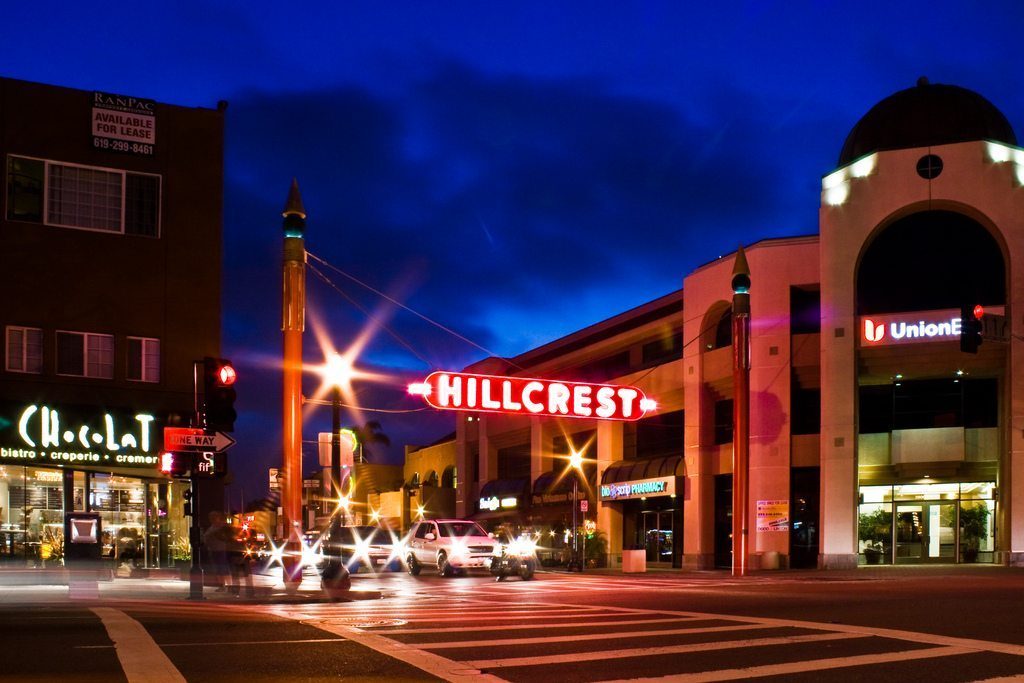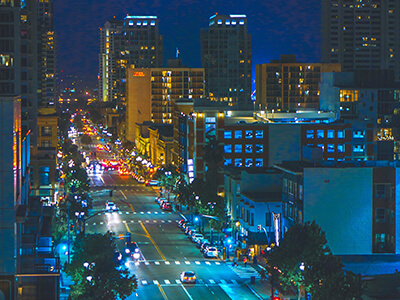Getting denser better: NIMBYism and developers (dispatch from San Diego)
Worldwide, unreasonable neighbour resistance (“Not In My Backyard”) is one of the greatest hurdles to the land-use intensification that modern cities need to be sustainable, accessible, and liveable.
Talk Wellington are looking at different ways to overcome it – here, profiling some progressive developers’ coalitions in San Diego, California.
This post was originally published on the blog Market Urbanism Report, an excellent read.
America’s Progressive Developers, San Diego Edition: the Hillcrest Gateway Council
[This is instalment #5 in the monthly cross-country MUR series profiling America’s Progressive Developers. Here are the articles on Miami, Charlottesville, New Orleans,San Antonio,San Francisco and Detroit.]
San Diego, California – There is a scourge afflicting U.S. cities, and it is a little thing called “downzoning” [Ed: meaning zoning controls that reduce the intensification of landuse, such as bringing in a lower height limit, or lowering a cap on the number of residences in a given area.] Over the past few decades, cities that were already suffering the side-effects of underdevelopment worsened their problems, passing regulations to further reduce build-out in central areas. Throughout the 1960s and 1970s, a large portion of Los Angeles, for example, was downzoned, even as population steadily grew. New York City has established a regulatory framework that would outlaw 40% of buildings today. Miami, thanks to parking regulations, effectively illegalised the type of development that created areas like Little Havana. And there are countless other examples, meaning that the dense, neo-traditional land use pattern which first made our cities great can no longer be replicated.
San Diego, too, may be subject to this downzoning trend. Like California’s other destination cities, San Diego has both a fast-growing population, and restrictive land-use regulations that limit housing supply. But rather than reforming their laws to increase land-use intensity, they’re doing the opposite. While visiting San Diego recently, I studied one neighborhood, Hillcrest, that was slated for downzoning. But I also discovered a property owner coalition, called the Hillcrest Gateway Council, that had been formed both to stop the downzoning, and to draw a new plan that would encourage an upzoning. The council has been partially successful since I left, serving as a possible model for how to prevent regulatory overreach elsewhere.
For background, Hillcrest is a fast-blossoming neighbourhood—San Diego’s longtime de facto “gaybourhood”—that is 2 miles north of downtown. It is on the northwestern edge of Balboa park, which is the city’s central park, and a focal point for its urbanisation, with surrounding neighbourhoods in each direction achieving partial or full walkability. Hillcrest is among the most urban of these areas, known in particular for its nightlife. The high property values throughout Hillcrest suggest that, under an open market, its density would only increase.

But existing zoning here and in nearby neighbourhoods is generally constrained, allowing either single-family residential or low-rise multi-family. And the process for loosening this is getting harder. San Diego is a case study in micro-local development policy, with a different “community planning group” representing each neighbourhood. These 16-member groups are made up of neighbourhood residents who are elected by their fellow neighbours. The groups have heavy influence on land use in their area, says Maya Rosas, a former consultant who lives in San Diego. When the city planning department wants to write a new neighbourhood plan every 20 or 30 years, it “does extensive outreach with the planning group, the planning group tells them what they want, and technically the city writes the plan incorporating the feedback they receive.” Because these neighbourhood groups typically consist of older homeowners, such plans, says Rosas, perpetuate NIMBYism.
One recent example was the Uptown Community Plan. It was drawn for the Uptown District, which is one of the leading commercial centers within Hillcrest. The current neighborhood plan was written in 1988, and allows a build-out of 34,600 housing units. Nine years ago, this new plan was submitted by the neighborhood group that would downzone the area, reducing build-out to 32,700 units. The plan was finally slated for city approval in the summer of 2016…until Uptown’s developers found out.
Developers and various commercial property owners in the area are a hodgepodge of family-owned businesses, joe schmoe landlords, and larger builders. Many of them have owned property in Uptown for decades, enduring an extended period of neighborhood decay. They have long held out in anticipation of San Diego’s interior revival, and now that this is happening, they would like either to develop their properties at greater heights and densities, or sell at a premium to other developers. So these Uptown property owners were shocked to hear that, rather than lifting regulatory burdens in the face of population growth and a housing shortage, the city might actually downzone Uptown. This would be especially catastrophic since approved community plans remain in effect for decades in San Diego.
Uptown’s developers responded by pooling together money and forming the aforementioned Hillcrest Gateway Council, a coalition of 15 area owners spread over an 11-acre area. They have both resisted the proposed downzoning, and published an alternative plan calling for greater heights, densities and public amenities.
Recently I had coffee, and took a tour, with two women who are spearheading this owner coalition, Elizabeth Robinson and Mercedes Sheehan. Both are asset managers for The Greenwald Company, an 8-person firm that has a small portfolio in San Diego and Chicago. The company, run by Bennett Greenwald, owns several adjacent lots in Uptown. Like much of the neighborhood, these lots are now moderately dense and generally uninspiring, with a gas station, a music store and a ramen bar, among other shops, sitting within cookie-cutter 1970s architecture. The buildings are fronted by clogged streets that have been oriented more for automobile through-traffic than for Uptown’s many pedestrians.

The Greenwald Company’s plans would be a dramatic upgrade. While the company will preserve the street-facing retail, it wants to build two modern towers–one that replaces the gas station, another that rises above one of the storefronts. The company wants to put one, and possibly two, pocket parks at the centre of the property.
A similar mentality drives other owners within the Hillcrest Gateway Council. Rather than developing their properties autonomously, the council’s alternative plan shows a shared vision among these 15 owners, wherein new buildings interrelate with new parks, public squares, improved streetscapes, and even a pedestrian mall. In other words, the owners want to join together in a collective act of neighbourhood building (this video made by the council provides more details).
Of course, this will require greater cooperation and deregulation from the city, and that’s what is interesting about the developer coalition strategy. The property owners pursued it, according to Robinson (who has since left The Greenwald Company for a job in Austin), because “we realized that we were more powerful together than if it was just one property owner.” They formed the coalition in 2015, and decided step 1 would be to hold meetings with the neighbors and the neighborhood planning group, to reach a compromise. Robinson said that quickly fell apart, because residents’ mentality going in was “you’re just a greedy developer.”
Hillcrest Gateway Council members did learn during the course of talks, though, that there was demand among neighbors for more parks. The neighbors may not have realized how such parks are actually funded–i.e. through more development, property tax revenue, and user traffic–but this is what they said they wanted.
“In one breath they would say ‘downzone downzone downzone’,” said Robinson. “And in the next breath they would say ‘we need more parks here’.”
These meetings thus gave the council a good sense of the bargaining chips they could draw into their plan. The final plan–with its higher densities and greater park space–was presented in 2016 to the city. Robinson said that it was well-received by staffers, because of the plan’s fundamentally urbanist nature.
But there is still a ways to go–before any upzonings could occur, the council first had to avoid the proposed downzonings for Hillcrest. That original downzone plan written by the Nimby neighborhood group went before city council in late 2016, and was rejected. It was replaced by a prospective new proposal that would increase heights in the area that the Hillcrest Gateway Council owners want to develop. But this new plan still needs to go through the planning department and city council approval process. Otherwise, Hillcrest’s 1988 plan remains in place—meaning Uptown will remain entirely as is, with the same build-out and the same low-rise character. Bennet Greenwald later said by phone that the Hillcrest Gateway Council has spent around $650,000 to form the coalition, hold numerous neighborhood meetings, draw the plan, hire lobbyists, and more. That figure could eventually reach an estimated $1.6 million — and of course will be wasted if the proposed upzoning never occurs.
If they do get it, however, then the Hillcrest Gateway Council will have provided a huge boost to San Diego. The city is suffering both a housing affordability crisis, and the legally-binding mandates from a Climate Action Plan that calls for more transit use and less carbon emissions. Building up neighborhoods like Hillcrest can help with those issues, while bringing more vibrancy to numerous San Diego neighborhoods, helping extend the urbanist momentum already occurring downtown.
Even more, the Hillcrest Gateway Council could provide a model for how to fight the regulatory grip strangling other cities. When faced with unreasonable constraints—or even downzonings—against their properties, developers can pool resources to create a political coalition and draw a plan. If this plan communicates a greater vision for the neighborhood than what exists, it might just grab the attention of local government, and get approved despite local resistance.
[Read the original on the Market Urbanism blog. This article was originally published by Forbes.]
Read more:
Fix the housing crisis: take the power local and let’s get dense
Previous Market Urbanism reports on progressive developers – America’s Progressive Developers. Miami, Charlottesville, New Orleans,San Antonio,San Francisco and Detroit.
Image credits:
- Banner – The Greenwald Company
- Hillcrest gateway sign – Wikimedia Common
- Street in Hillcrest – hillcrestbars.com
Leave a comment